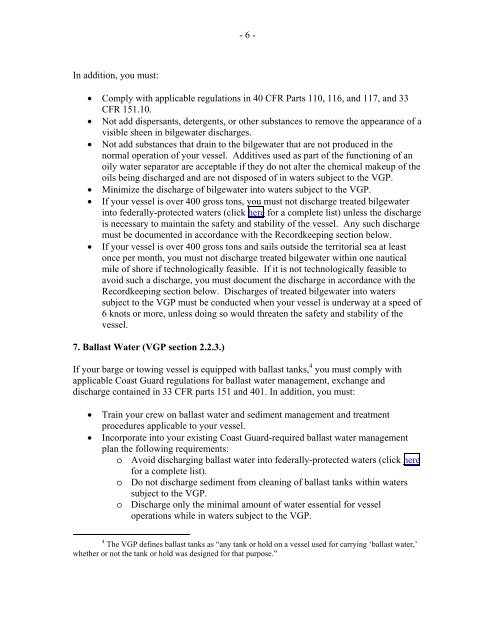AWO Recommended Practice Guide - The American Waterways ...
AWO Recommended Practice Guide - The American Waterways ...
AWO Recommended Practice Guide - The American Waterways ...
You also want an ePaper? Increase the reach of your titles
YUMPU automatically turns print PDFs into web optimized ePapers that Google loves.
- 6 -In addition, you must: Comply with applicable regulations in 40 CFR Parts 110, 116, and 117, and 33CFR 151.10. Not add dispersants, detergents, or other substances to remove the appearance of avisible sheen in bilgewater discharges. Not add substances that drain to the bilgewater that are not produced in thenormal operation of your vessel. Additives used as part of the functioning of anoily water separator are acceptable if they do not alter the chemical makeup of theoils being discharged and are not disposed of in waters subject to the VGP. Minimize the discharge of bilgewater into waters subject to the VGP. If your vessel is over 400 gross tons, you must not discharge treated bilgewaterinto federally-protected waters (click here for a complete list) unless the dischargeis necessary to maintain the safety and stability of the vessel. Any such dischargemust be documented in accordance with the Recordkeeping section below. If your vessel is over 400 gross tons and sails outside the territorial sea at leastonce per month, you must not discharge treated bilgewater within one nauticalmile of shore if technologically feasible. If it is not technologically feasible toavoid such a discharge, you must document the discharge in accordance with theRecordkeeping section below. Discharges of treated bilgewater into waterssubject to the VGP must be conducted when your vessel is underway at a speed of6 knots or more, unless doing so would threaten the safety and stability of thevessel.7. Ballast Water (VGP section 2.2.3.)If your barge or towing vessel is equipped with ballast tanks, 4 you must comply withapplicable Coast Guard regulations for ballast water management, exchange anddischarge contained in 33 CFR parts 151 and 401. In addition, you must:Train your crew on ballast water and sediment management and treatmentprocedures applicable to your vessel.Incorporate into your existing Coast Guard-required ballast water managementplan the following requirements:o Avoid discharging ballast water into federally-protected waters (click herefor a complete list).o Do not discharge sediment from cleaning of ballast tanks within waterssubject to the VGP.o Discharge only the minimal amount of water essential for vesseloperations while in waters subject to the VGP.4 <strong>The</strong> VGP defines ballast tanks as “any tank or hold on a vessel used for carrying ‘ballast water,’whether or not the tank or hold was designed for that purpose.”















